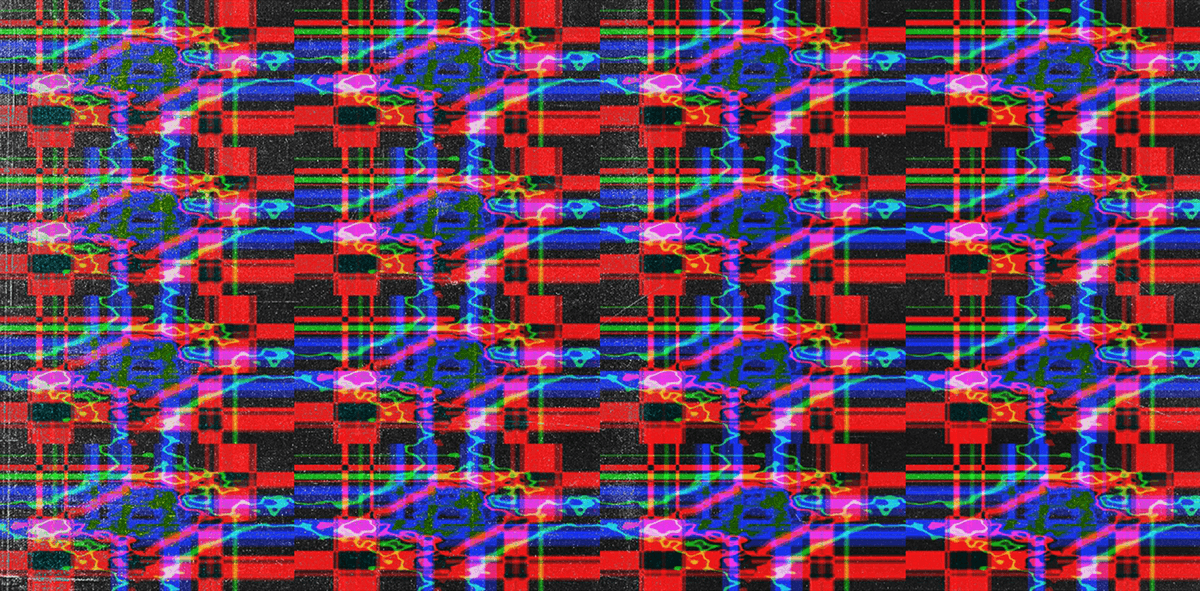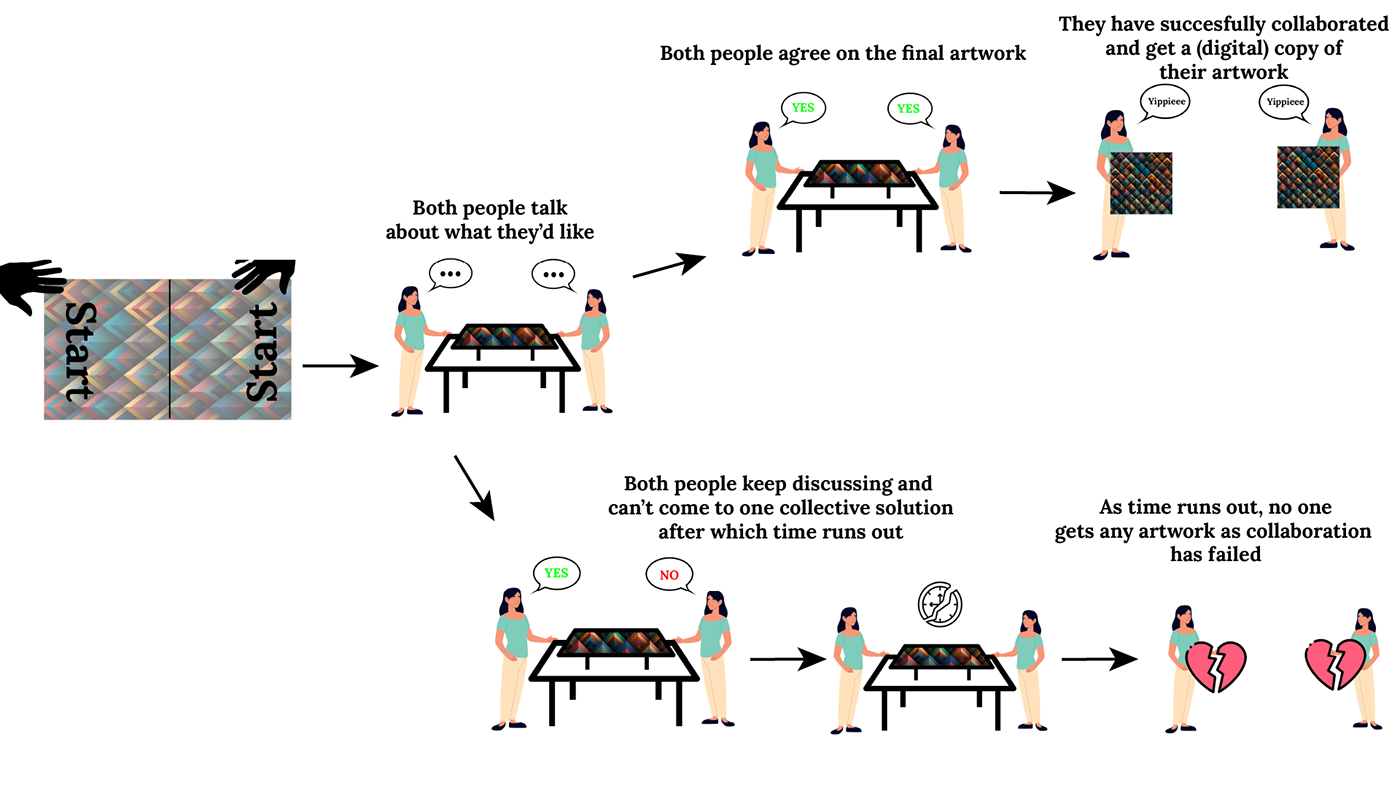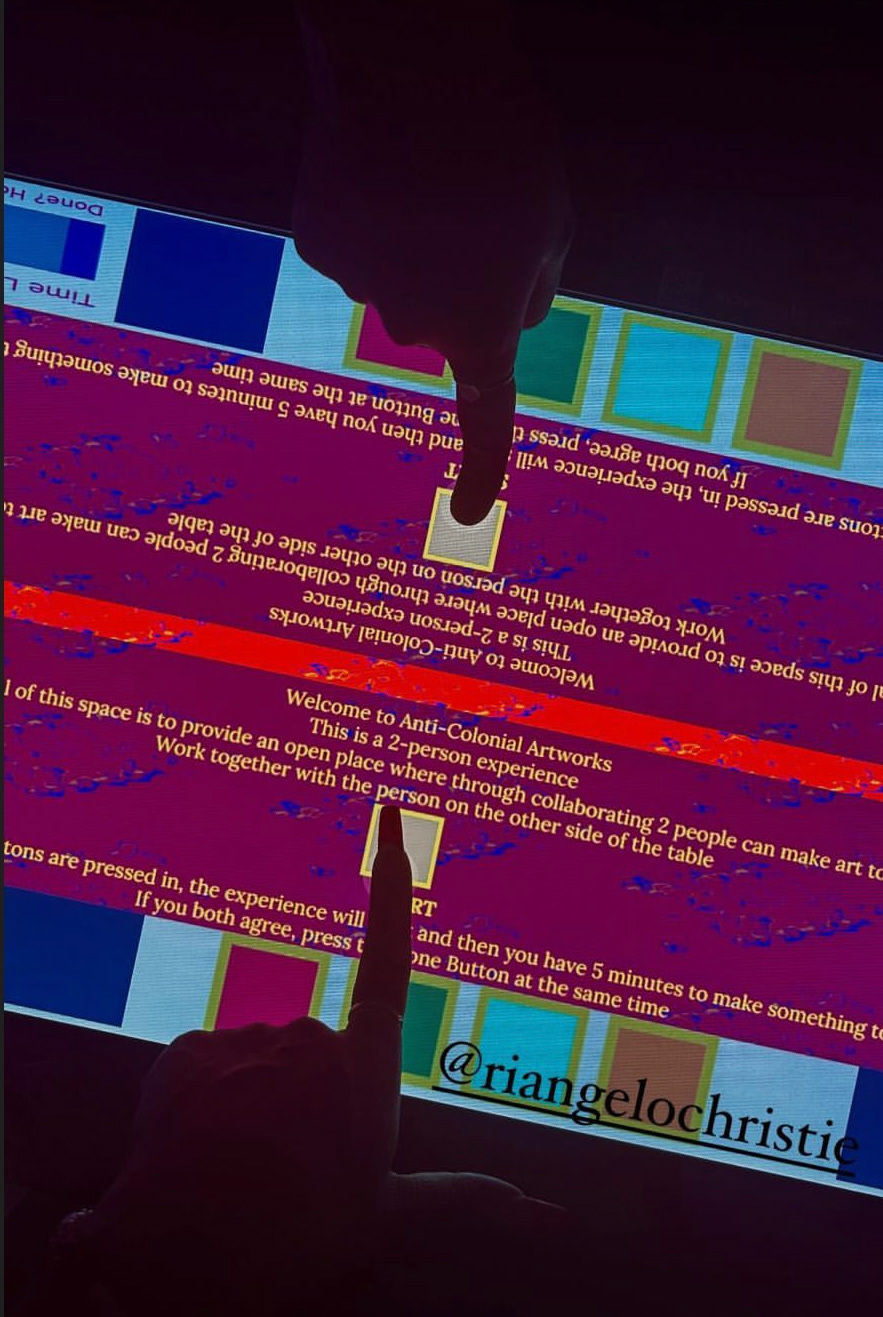Anti-Colonial Artworks

Anti-Colonial artworks is a 2-person interactive experience where the goal is for the 2 people in the experience to collaborate and make a piece of art together. This documentation will highlight and explain the concept, the process I went through, the final result and also show a lot of the artworks made. This interactive piece was made using TouchDesigner and a touchscreen.
This project was done as part of Rose Academy's Visual Storytellers program. Special thanks go to my artistic coach Andreas Tegnander, to the people at Rose Academy, namely Atlynn Vrolijk and Larinza, Eric Seton and last but not least to our curator Guinevere Ras.
This piece has been exhibited at:
Rose Academy Dutch Design Week 2023
Rose Academy Unheard-OF(2024)
Graphic Design Fair 2024 by Nai Booksellers and The Nieuwe Instituut
The Whinehub First Edition
If you would like to only see the different Anti-Colonial Artworks people made, scroll all the way to the end.
Concept
Art which comments on colonialism is often focused on colonialist history or economic structures that exist because of colonialism. However, colonialism is much more than that and is also reflected and ingrained in our ways of thinking, hierarchy systems and interpersonal relationships. One particular oppressive system is called the student-teacher relation within the banking concept of education as referred to by Paulo Freire, the student knows nothing and the teacher knows everything and decides what is best for the student and makes all the decisions for the "benefit of the student". One party decides and the other listens and absorbs, one dominates and the other is dominated.
A good example of this, coming from personal experience as I was born and raised on Curaçao, is the neocolonial relation between Curaçao and the Netherlands. Ex-colony and ex-colonizer. The island, like many (ex-)colonies, is still dependent on the Netherlands and often asks for financial aid. When this financial aid is given however, it is often met with a lot of rules and restrictions. “You can have this money, but you have to use it on this, this and this because we know better, because we have more experience with these things...” Even though the aid is supposed to be for the benefit of Curaçao and its people, we are often very much excluded from the conversation.
This one-way relation is not only present between (ex-)colonies and (ex-)colonizers but also presents itself in our day-to-day lives and how we interact with others, how we work in groups, how we collaborate etc. To break away from the chains and remnants of colonialism, we must also break away from its oppressive ways of thinking, which we often gravitate towards as it's all that we know.
In Anti-Colonial Artworks we provide an alternative way of thinking, an open space where, ideally through collaboration and dialogue 2 people can make art together: no boss, no hierarchies, no domination but true collaboration. Through an interactive panel, 2 people can make an artwork together. Both sides of the panel control the generative artwork in the exact same way. In the space of Anti-Colonial Artworks, the influence of both parties is truly equal. Both people in the experience must agree on the final artwork to finalize it, one cannot act with their own selfish interests but must collaborate with the other person as a means to shape the future together and reach their end goal, making a piece of art.
Early Sketches
Originally, the idea was for this to be a continuous multi-person experience with as many people as you wanted all centered around a round meeting table to promote conversations. The idea was that anyone regardless if they had been in the room for 2 minutes, 10 minutes or 30 seconds could influence the artwork being shown on the table.







First Interactive Prototypes
My first goal was to get some interactive prototypes up and running and ready for testing as fast as possible. These first interactive prototypes, which were not ready for testing with real people, are shown below.
Testing: Phase 1
To validate the basis of the interaction and the installation, I tested the interactive piece at multiple moments. This next paragraph will cover the first phase of testing. I mainly tested to see if the designed interaction was intuitive, how the experience felt, how the buttons felt as controls, if testers felt like they had a lot of influence and control on the look of the artwork and most importantly if the testers felt like they were making a piece of art together and if so, how that felt and any thoughts they had on the concept. Below are some videos of the tests.

Conclusions From First Phase Of Testing and Next Steps
From my own notes: "From the user tests I can conclude one main thing. The experience is currently very confusing. Users feel more like they are solving a puzzle and trying to figure out what the buttons do then making something together. There doesn’t seem to be a very clear correlation between pressing a button and changing the artwork for most people. “Too abstract” was something that was said a lot. Currently, the generative visuals are much too abstract and there isn't a clear relation between them and the controls seen. It is extremely unclear what each button does. One group was able to partially figure out what the buttons do and how they relate to each other but not a single group really understood it fully.
Originally, as part of my idea, part of the experience should also be discovering and understanding the environment and how the controls work, but seeing how the tests went this current state is just too confusing. People have no idea what the end goal is, have no real incentive to interact, have no idea how the controls relate to the artwork and if it becomes too confusing will quit quickly. I personally see a lot of generative art and like abstract art which is probably why I don’t consider it as very confusing, but if I want to get my main point across and make a collaborative space I have to make it clear and not confusing for the average person. It can be abstract but the controls still need to be intuitive to some sense. Users should be mainly talking and collaborating instead of figuring out how the buttons work.
The form of the buttons could also be subject to change, as again there isn’t much clear relation between them and the visual. Testers also described they’d like to see more color.
However, the concept was liked a lot. Everyone responded very positively to the concept and also liked the physical setup a lot. Having 2 people across from each other really set you up to collaborate and talk more, regardless of how confusing it was. It was still a collaborative shared experience."
Seeing how badly the tests went, contrasted by how well the 2-person setup worked, gave me hope that I was going in the right direction. After this iteration I also decided to make the experience a strictly 2-person experience for further iterations, as this setup worked very well in terms of getting people to talk and collaborate, which is exactly what I want.
Storyboard
To then map out in more detail how the interaction would go, I made a storyboard.

Dutch Design Week Prototype
During Dutch Design Week 2023 I had the chance to exhibit a prototype as part of Rose Academy's stand. I also used this as a key moment for testing and collecting a lot of feedback. Here, follow some videos from Dutch Design Week and the sketch that inspired and was a revelation for the new visuals.







The reactions during Dutch Design Week were to be frank, amazing. I had many many good reactions. People loved the concept, way of thinking and train of thought and the controls felt very intuitive. I had printed out instructions but they were not even necessary as many people figured out the controls for their generative artwork on their own. This prototype was not the proper experience. It had no clear start and end point and people could essentially do the entire experience alone. For my final iteration for the expo the goal was thus to make the prototype a strict 2-person experience. One you need to start and end, together, with a timer specifically as this time crunch gives people a tangible goal to work towards. "Make a piece of art together before time's over.
Final Expo
The final step. For my final expo, I took along all the things I learned along the way and grew my prototype to one final iteration. After which I also made the final design of my space.
Space
I had different sketches, designs and iterations for the design of my space. What I was aiming for was for my space to feel comfy, cozy, personal and also as Curacaoan as possible, using references from my own personal experience. I was also lucky enough to be given my own personal space for our exhibition. Below I show my first sketches(both for the space and interaction).




Below is the first design which I had in mind. The left would be what it looks like from the inside and the right from the outside.


After a talk with the curator, I changed the look of the space. In this second iteration, I focused much more heavily on designing the space and taking inspiration from my Curacaoan childhood. The idea here was to paint the space to look like the inside of a landhuis on Curaçao, I took inspirations from these as they look very much like the house I lived in as a child and I always found them beautiful. To make the space feel more cozy and comfortable I also wanted to surround every table with curtains. Specifically paying attention to make sure I chose curtains that once again felt very nostalgic and Curacaoan. Back in Curaçao basically everybody had curtains with some intricate pattern on it.
My choices were mainly done as a way for me to retake and reformulate these spaces heavily influenced by colonialism, which is why I wanted it to feel like I was just back home but then in a kind of revived version of home. Below I for example also use pictures from my childhood home as inspiration(the woman in the pictures is my mother).




Sadly I couldn't paint the space and we didn't manage to put a flag at the entrance but it was possible to hang up some posters in the space. To make the space feel even more Curacaoan and nostalgic I also put down a vinyl player in the space and would constantly swap between different vinyls of classic Curacaoan artists and also sanctified the space using Flo Rida Water, which is very Curacaoan tradition. The projection I put in the space was also a picture of me from my childhood I used.
Final



Became:
The responses for the final expo were overwhelmingly positive. The controls were intuitive, people felt like they were collaborating and really had to work together to make something. Everything I was aiming for landed. The artwork itself was interesting, the controls were intuitive, the interaction stimulated conversations and collaboration, everyone recognized and empathized with the train of thought and many people(those with Caribbean roots) noted how they felt that the space felt like a room in their grandma's house in the Caribbean.
There were many moments where legitimate strangers decided to do the experience together, talked, collaborated and made something. I wasn't expecting this to happen at all because it just seemed very unlikely to me, but to see true strangers come together and collaborate warmed my heart.
Below I will show many of the Anti-Colonial Artworks people made:






































































